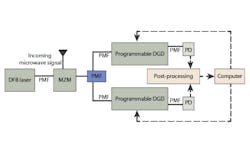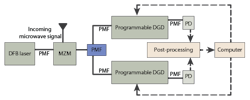Differential Group Delay Modules Aid Instantaneous Microwave Measurements
Optoelectronic techniques applied to RF technologies is a growing trend, and with good reason. The benefits optoelectronics provide are immunity to electromagnetic interference and extremely wide bandwidth transmissions. Now, researchers Songnian Fu, Junqiang Zhou, Perry P. Shum, and Kenneth Lee of the Network Technology Research Centre and Temasek Laboratories of the Nanyang Technological University, Singapore, have practically demonstrated a photonic technique to create an adjustable microwave frequency measurement system.
After a microwave signal of interest is received, the signal is modulated on an optical carrier using a Mach-Zehnder modulator (MZM). A dual pair of programmable differential group delay (DGD) modules then receives the optically modulated microwave signal. The DGD pair introduces unique microwave power fading effects on the optically modulated signals. These effects enable a fixed relationship between the frequency and power of the signal to be derived after the signals are coupled into separate photodetectors for electrical conversion.
DGD module adjustment can be used to vary both the frequency measurement range as well as the resolution range. The research team experimentally verified their design with continuous-wave microwave frequency signals from 15 dBm to 3 dBm of power. The measured errors of the signal were below 0.04 GHz for the entire measurement range of 4.5 to 6.5 GHz.
See “Instantaneous Microwave Frequency Measurement Using Programmable Differential Group Delay (DGD) Modules,” IEEE Photonics Journal, Dec. 2010, p. 967.
About the Author
Jean-Jacques DeLisle
Jean-Jacques graduated from the Rochester Institute of Technology, where he completed his Master of Science in Electrical Engineering. In his studies, Jean-Jacques focused on Control Systems Design, Mixed-Signal IC Design, and RF Design. His research focus was in smart-sensor platform design for RF connector applications for the telecommunications industry. During his research, Jean-Jacques developed a passion for the field of RF/microwaves and expanded his knowledge by doing R&D for the telecommunications industry.

